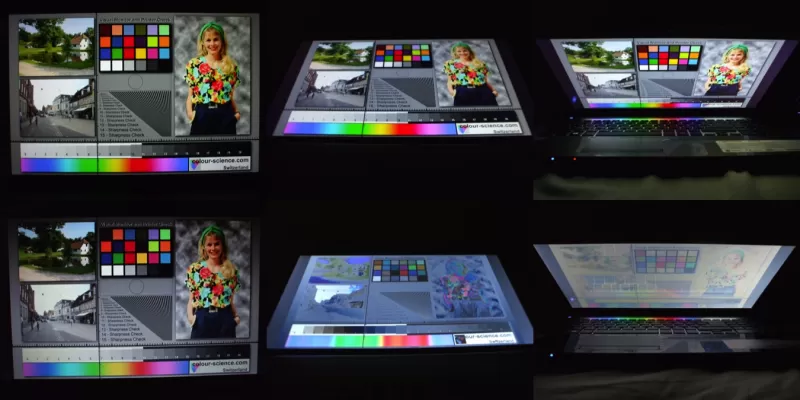Modern laptops and monitors use two types of matrices — VA and IPS. The first is cheaper, the second is more expensive. But the difference between them is not limited to price.
Matrices differ in design and performance characteristics — color reproduction, viewing angle, response speed, brightness and other parameters. Therefore, if you plan to buy a laptop or monitor for any “special” purposes, such as computer games or graphic design.

Differences between VA and IPS matrices
All the differences between the two types of matrices — VA and IPS — can be summarized in one comparative table:
|
|
|
|
|
|
Almost absolute
|
Relatively small
|
|
|
High
|
Relatively small
|
|
|
Low
|
High
|
|
|
Low
|
High
|
|
|
Low
|
Very high
|
|
Support for sRGB and “professional” color profiles
|
Not
|
There is
|
|
|
small
|
excellent
|
|
|
From 1 ms
|
From 3 ms
|
|
|
up to 150 degrees
|
up to 178 degrees
|
In general, there is no fundamental difference between VA and IPS. However, in some cases it is better to select only a certain type of matrix.
Comparison between VA and IPS in most parameters
So, to compare VA and IPS, we select the following parameters:
-
Illumination uniformity;
-
Black Depth;
-
Contrast;
-
Color efficiency when working with HDR;
-
viewing angle;
-
Response speed.
Illumination Uniformity
It should immediately be noted that the level of backlight uniformity depends not so much on the matrix itself, but on the quality of the monitor itself. But if we imagine that the quality of the LED panel (which can be located both directly behind the layer of color pixels and along its edges) is the same, then a comparison can be made.
The VA technology itself provides a more uniform pixel spacing, which makes the backlight appear even, without any white or yellow patches towards the edges. But IPS can have small “skews”, which are often located directly in the corners of the screen. However, if the display is of high quality, the backlight will be uniform.
But if absolutely uniform illumination is required — for example, if you spend a lot of time at a computer or TV and look not at “one point”, but run your eyes around the screen, then it is better to choose VA.
Black Depth
Here the clear leader is VA. In 2019, the minimum black brightness on such matrices is about 0.015 nits. And for IPS, this parameter is 0.075 nits.
It is self-evident that VA provides deeper and more natural blacks. This is important when working in dimly lit rooms, viewing contrasting images and films. In addition, in some cases — for example, when working with HDR content — deeper blacks provide an increased visual “cinematic” image.
Contrast
And here VA is also in the lead. Static contrast ratio — the difference between the brightness of a white and black point — on such screens can be up to 3500: 1, precisely because of the deep black color.
But the maximum static contrast ratio of IPS matrices is much less and amounts to 1500:1.
The increased contrast of VA matrices provides both a high “cinematic” image and somewhat reduces eye fatigue during prolonged work at the corresponding monitor. In addition, it visually increases the detail of images.
Color efficiency (when working with and without HDR)

HDR technology — an expanded range of shades — helps to make images more impressive, saturated and “juicy”. However, the quality of improvement largely depends on the matrix itself.
Due to the increased contrast, VA panels provide better color performance than IPS, but only when running without HDR. It is worth including an extended range of shades — and IPS “show their power.” Of course, shallow darks remain shallow no matter how much you want to improve them, but bright colors and shades become much more saturated, impressive and simply beautiful.
In addition, IPS panels support professional calibration. For example, “fitting” to the sRGB gamut, which is the generally accepted standard when working with graphic and web design.
In this way:
-
If you do not plan to work with HDR content or plan very rarely, you should choose VA;
-
If you plan to work with HDR content on a regular basis or if you need to calibrate to sRGB, then IPS is a better choice.
Viewing angle
And here the absolute leader is IPS. Matrices of this type provide a viewing angle of up to 178 degrees, and regardless of the direction of view, the colors will be realistic and natural. At VA already at an angle of 20–25 degrees there is a slight “shift of shades”, and after 50 degrees it becomes very noticeable.
Therefore, if you plan to look directly at a monitor or TV, you can choose VA. But for greater freedom of action, IPS is recommended.
Response speed
And according to this parameter, VA is clearly in the lead. Displays of this type have a response speed of 1 millisecond. Therefore, the monitors equipped with them are well suited for gamers and fans of films with numerous dynamic scenes.
IPS displays have a response time of 3 milliseconds. They are not well suited for e‑sports, as in intense battles, a trail remains behind objects on the screen.
Which is better to choose — VA or IPS?
If you have a choice between matrices of this type, then you should first of all determine what you will use the monitor, TV or laptop for.
IPS screens are great for:
-
Designers and artists. They not only support sRGB calibration, but also provide natural transmission. What you see on the monitor is what you get on paper;
-
Owners of PlayStation 4 Pro, other latest generation consoles, graphics cards with HDR support. Despite the desaturated black, the other shades are brighter and richer.
VA screens, in turn, will be a good solution for:
-
eSportsmen. The minimum response time decides;
-
People who have to work a lot with documents. Increased contrast improves text readability and reduces eye strain;
-
Lovers of “deep black”, especially in films.
-
However, there is no fundamental difference between VA and IPS. Both of these display technologies provide high image quality.

Добавить комментарий
Для отправки комментария вам необходимо авторизоваться.